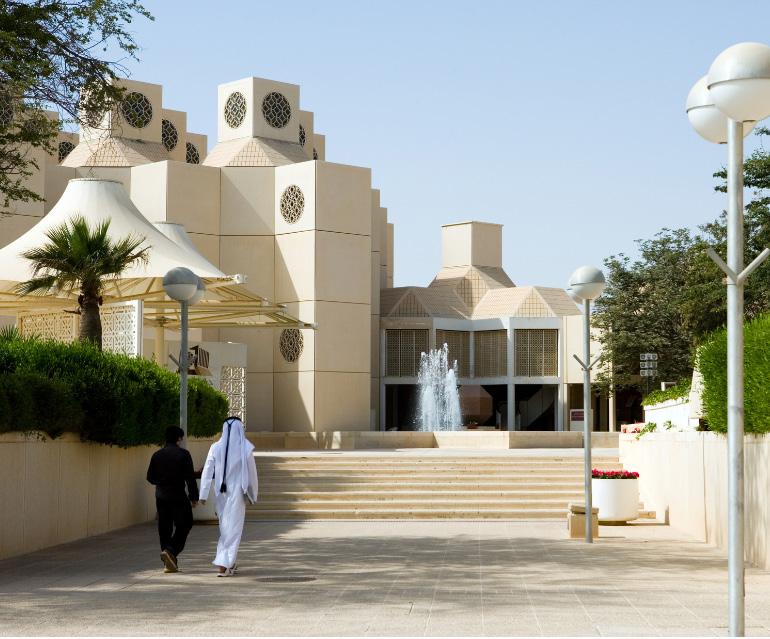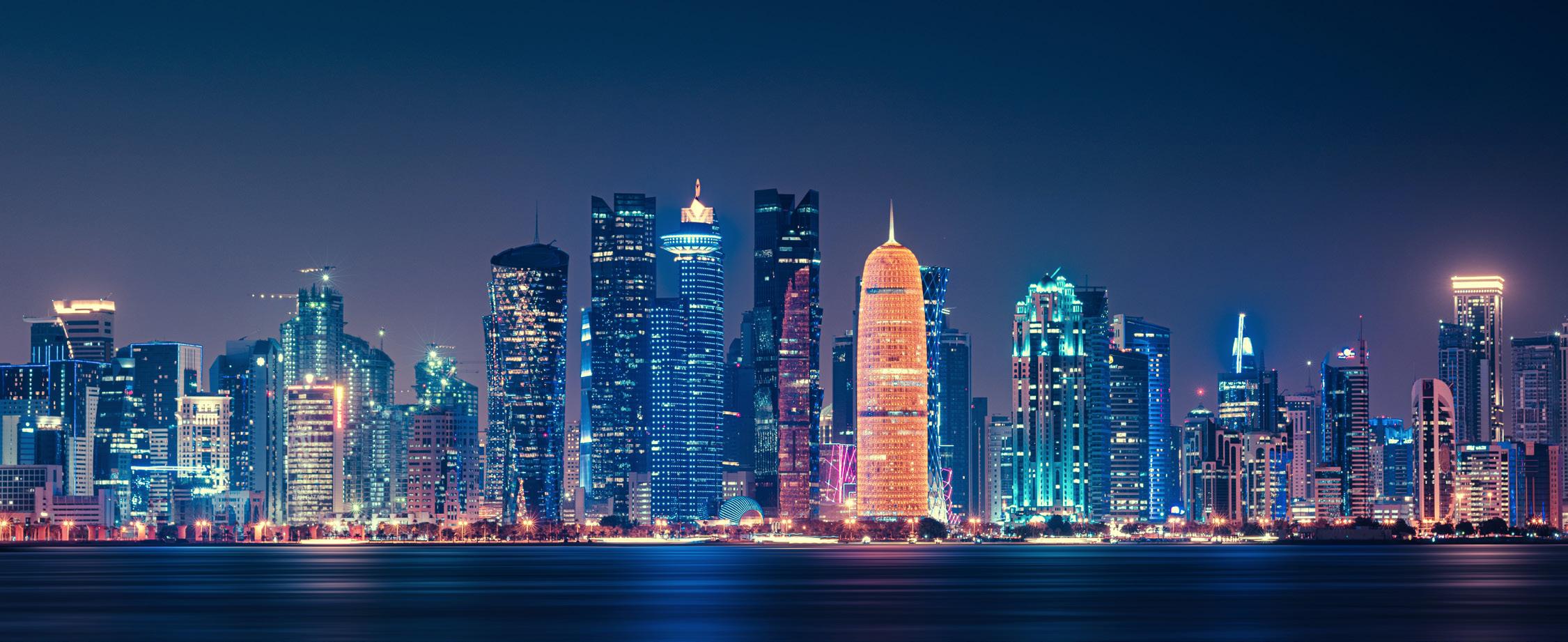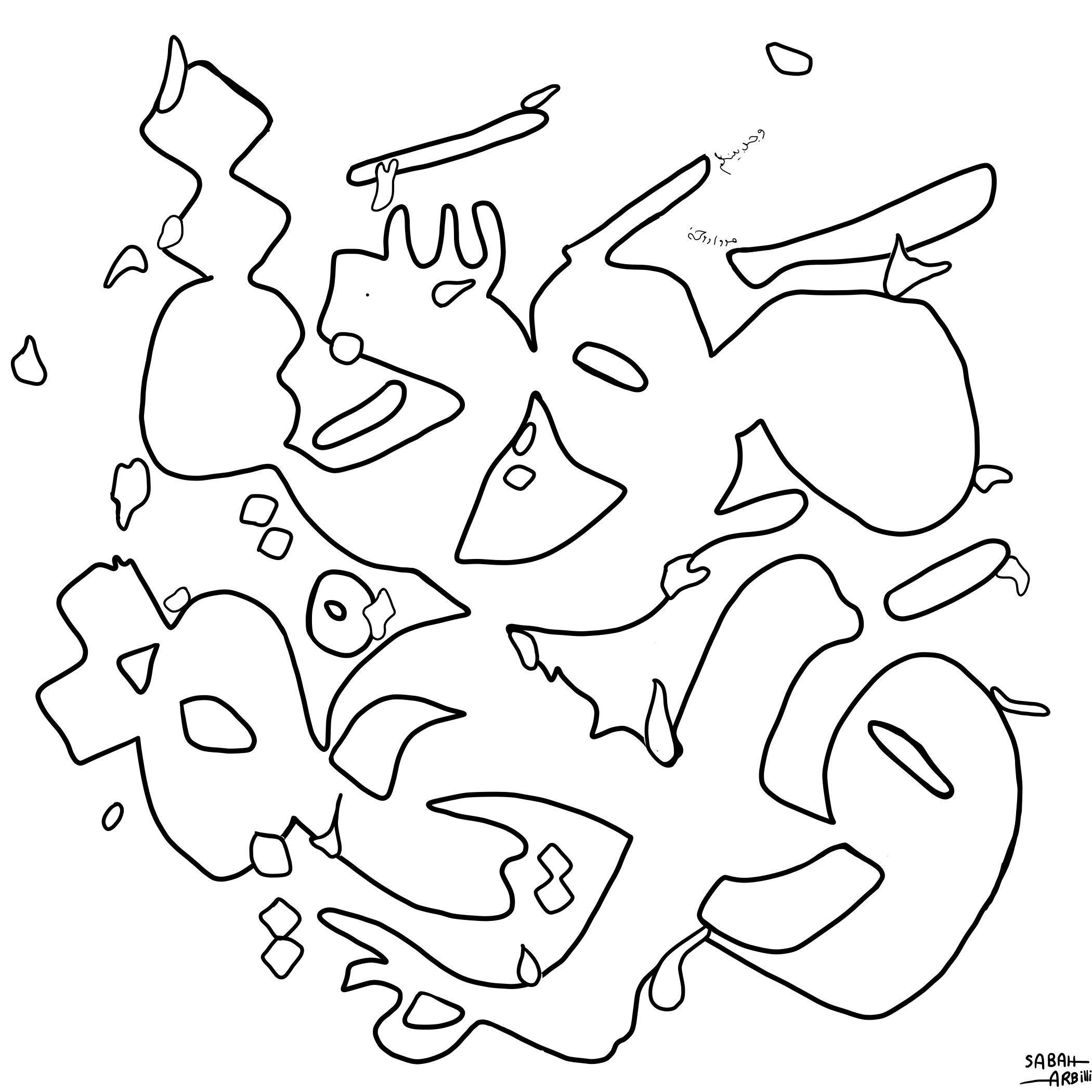
14 minute read
Transitions in the Urban Built Environment of Qatar’s Capital City by Dr. Mohanalakshmi Rajakumar
from A2Q - Issue One
by QatarAmerica
Transitions in the Urban Built Environment of Qatar’s Capital City
by Dr. Mohanalakshmi Rajakumar
Advertisement
Introduction
Driving through West Bay, as Qatar’s business district is known, is to travel through roads lined by high-rise buildings with glittering glass façades. These testaments to modernity tower over dust-swept streets, the twists of steel and glass belying the desert heritage of this emirate. How and why did Western architecture come to dominate this desert landscape? In what ways does the state’s fashioning of a modern identity challenge the environmental constraints of the desert climate? The West Bay district in Qatar’s capital city of Doha is a clear example of how the globalization of urban design produces an “international malaise” of using the same building materials, methods, and styles regardless of the specificities of the particular country, city, or residents.i Skyscrapers, as political geographer Donald McNeill explains, have been exported by Western design firms as a symbol of modernity and progress in contemporary urban landscapes. These are more than tall buildings — they are synonymous with industry and growth, conveying both financial and political significance (41).ii
As skyscrapers have become well-established in the urban centers of North America, we now see these and other superstructures flourishing across the capital cities of the wealthiest nations in the Middle East. Statement buildings have become the means to showcase "a massive import of architectural language, a stereotype vocabulary of built form that is essentially Western in character. Yet it is being associated worldwide with images of progress, prestige, and future orientation" (345).iii The irony of transplanting skyscraper designs to climates for which they are not suited is that the glass tower then becomes an example of form without appropriate function, and a major reversal of the basic design principle advocated by American architect Louis Sullivan (1896).iv Sullivan and his contemporaries struggled with the notions of modernism and design during the late nineteenth-century urban expansion in America. Specifically, they contemplated the ways in which a building's form could further enhance the purpose or the goals of the occupants.
Similar dilemmas face the development of the Gulf Cooperation Countries (GCC) of Kuwait, Qatar, Oman, Bahrain, Saudi Arabia, and the United Arab Emirates. This article discusses the ways in which the discourse and material facts of modernization in Qatar are seen in the design aesthetic of the built environment. We will compare the traditional ways in which the residents of Qatar cooled themselves in the years before the advent of air conditioning and multistory structures. The rapid rise toward modernization, fueled by oil wealth across the GCC, coincided with an effort to promote a more international aesthetic that traded traditional Islamic architectural elements in favor of more a modern, Western aesthetic.
This trajectory elicits mixed views from citizens as Sharon Nagy notes: "Local residents usually react to the aesthetic, spatial, and social transformation of the city with mixed feelings, uncertain whether the advantages of development outweigh the disadvantages. On the one hand, they respond with awe and pride for the present level of development. On the other hand, they express longing and nostalgia for the past."v We will explore the ways in which modern urban design in the Arabian Gulf presents a rupture in traditional cooling practices and heritage building.
Modernization and Desert Life
The initial modernization phase in most of the GCC countries spanned an average of ten years of rapid infrastructure expansion following the discovery of oil. The first such push occurred in Saudi Arabia in the 1970s and 1980s. As the first to discover and export oil on a large scale, the Saudis initiated two five-year plans—one from 1975 to 1980 and another from 1980 to 1985—to develop showpiece buildings and multiuse projects that would project a modern face to the international community.vi Soon to follow were the United Arab Emirates, with the notable case of Dubai (1990–2000), and, not far behind, Qatar (2006–2016).
Before modernization, everyday life for most citizens and residents consisted of sustainable cooling practices. Most houses in Qatar, for example, had adaptive window features called the roshna, a small window set below a larger window. This was in addition to a basjeer, or hole to let air escape. One of the respondents in our interviews about traditional passive cooling practices describe it thusly: "When you open the windows and basjeer as well, the room gets cooled from everywhere, north, east, south, and west and you won’t feel the heat. [This was] an air-conditioner alternative."vii
In addition to structural elements within the homes, residents remember that building materials were chosen with an eye toward the climate. "We used to stay in houses made of clay and straws which cool us. In summer, it won’t transfer heat as it doesn’t include either iron or rocks. It cools the house from inside."viii The participants in our study reflect on their largely successful attempts to create microclimates in their homes and neighborhoods to deal with the harshness of the desert climate in the hottest months, typically from May to September.
In Qatar, as well as the GCC as a whole, the introduction of air conditioning rapidly grew in popularity with the increase of wealth. Before, people changed their behavior to accommodate to the weather: "the ACs were used sometimes. Otherwise we sleep on the roof to overcome the heat."ix Now, the luxury of air conditioning has become a necessary, assumed everyday technology without which modern life in the desert might not be possible: "There are families using the
Doha Tower. Doha, Qatar. Photo courtesy of Iman Soufan
ACs in day and night even if they were traveling and out of the country."x Currently energy consumption in Qatar is increasing at an annual rate of 15%.
But such overreliance makes the region unsustainable in the long term and would not be as necessary if modern buildings used traditional shading and cooling practices. As Andy Dean, head of façade engineering at WSP Parsons Brinckerhoff Middle East, explains, with economic growth and development came the divisive presence of technology in the design process: "Unfortunately, modern technology brought with it an arrogance that encouraged us to throw away some of those ancient natural solutions. We had electricity to run air conditioners, and plastics to provide insulation."xi In the early phases of nation building in the GCC, little thought was given to the environment, either culturally or ecologically in the creation of megastructures such as the Burj Khalifa, currently the tallest building in the world. These spires of glass are tributes to the development of Gulf economies and the abundance of wealth created by petroleum and natural gas reserves.
What came next, however, was a major shift away from privileging Western aesthetics in favor of

Modern wind towers in Qatar University. Doha, Qatar. presenting a more grounded, regional identity to the world. With growing Islamophobia in the Western world and negative media attention, Gulf nationals expressed an unease in the blatant disregard for their cultural heritage.
This public sentiment, combined with the practical concern of maintaining such structures in the harsh desert climate, resulted in ongoing discussions about Arab urban design. In what ways were traditional towns and buildings constructed with the landscape in mind? And could any of those interventions be used in the current environment? What we see is a concerted effort to include classical cooling features of Arab building design that are also key examples of Islamic architectural features.
Transitions in Gulf Architecture
The newest skyscrapers and other high-profile building projects in the GCC incorporate wind towers and the traditional Islamic sunscreen or lattice, the mashrabiya. Mashrabiya are traditional screens used throughout buildings that served a dual purpose: as a cooling layer between the window and the interior of the house, as well as a shield to keep female occupants from the direct view of the public. Including a screen façade on the exterior of buildings in the Gulf is a return to the traditional function of this design element: "external shading like mashrabiyas, louvers and awnings are key to reducing solar heat gains on building interiors."xii The western counterpart to this architectural feature is known as the brise soleil where screens are used to diffuse the amount of direct sunlight into a building. Their modern secondary function is to provide a visual cue of the region’s Islamic heritage. Mashrabiya now serve two functions in modern construction in the GCC: to cool a building and to demonstrate the design architect’s knowledge of heritage building practices. In the present-day built environment of the GCC,

Wind Towers. Doha, Qatar. Photo couresty of Alan Holden.
these patterned screens demonstrate "how sustainability narratives are mobilized together with nationalist tropes about modernizing Qatar and building up the country’s international prestige, while preserving local traditions and culture through the built environment."xiii
Examples abound across the GCC of the inclusion of a patterned screen as a way to limit sun exposure for the energy-intensive glass towers. In Qatar, one of the most notable ones is the Doha Tower, or Burj Doha, designed by French architect Jean Nouvel. At 761 feet, the overlaid lattice covers the entirety of sunshade, cooling the glass interior. From afar the building and façade are viewed as a single item. Up close you get the detail, the layers and the thickness. Hafid Rakem, the project’s Doha-based manager describes how the screen allows the interior and exterior to interact inside the building: "Nouvel used the mashrabiya to create a relation with the exterior and a play with shadows. Unfortunately, the Middle East has many 'aquarium towers' which are not transparent and have no interaction with outside."xiv Buildings in Qatar are not the only ones featuring high tech versions of traditional patterned screens. Examples of mashrabiya being used to modify ultramodern buildings abound across the GCC. The more recent ones include the Kuwait Investment Authority, the Abu Dhabi Investment Council, and Riyadh Tower. Cleaning the buildings in these arid climates provides a new set of challenges because of the scale of these projects. The dilemmas of rusting metalwork and extensive labor costs in maintaining and cleaning these structures presents additional evidence of how the form of the mashrabiya is being used without thought to the various functions it might impact. Such issues indicate that the wholesale adaptation of heritage features in building raises a new set of considerations.
Wind towers were traditionally used as ventilating structures in buildings throughout the Arabian Gulf and also Iran. Their value in arid climates is their ability to cool buildings without using electrical energy (78).xv There are numerous styles of wind towers, often classified by how many openings or vents they have at the top of the column. Square, hexagonal, and rectangular wind towers are among the most common used in Iran and the GCC.xvi
Education City, the multi-university project sponsored by the Qatar Foundation, is another interesting place to study the contrast in the nation’s shifting design aesthetic over the last ten years. While the buildings of West Bay are a testament to financial and business acumen, the investment in university education is a concerted effort to migrate from a rentier state into a knowledge based economy. The six American branch campuses are housed in unique, purpose-built buildings created by world
renowned design architects. As such, the range of features used in these buildings indicates both the level and interest of the design architect in heritage building practices for the desert climate. The design of these buildings is an articulation of identity shaped by these international design firms. In two examples, we will see how the incorporation of Islamic features does not necessarily equate with building function. Japanese designer Arata Isozaki’s ultramodern vision for the Weill Cornell Medical College in Qatar features a minimalist aesthetic with mostly white interiors and marbled surfaces whose geometric patterns are largely unseen by the untrained eye. Completed in 2003, the building features two linked 200 meter hallways with 40-foot-tall ceilings. The Liberal Arts and Sciences (LAS) building, also an Isozaki project, features similar white minimalist interiors and wide interior hallways, as well as an exterior façade that features cutouts of geometric patterns. Both the Cornell and LAS buildings have wind towers as incorporated forms in their structures. Despite the presence of wind towers, traditionally used for cooling, air conditioning units in the LAS structure, however, are in the floors of the classrooms, offices, and cafeteria, often causing people to place objects such as notebooks or folders over the vents in order to regulate the temperature.
Compare these ideas with those of the Mexican design firm Legorreta and Legorreta. The firm consciously and purposefully used inspiration of Islamic architecture from Spain and Mexico in its design of four buildings in Education City. The Legorreta buildings include the Texas A&M University in Qatar (abbreviation TAMUQatar, completed in 2007), Carnegie Mellon University in Qatar (abbreviation CMUQatar, completed in 2009), Hamad bin Khalifa University Student Center (abbreviation HBKU, completed in 2011), and Georgetown University in Qatar (abbreviation GU-Q, completed in 2011). Victor Legorreta, partner and managing design director, referenced the four elements used in each building—color, geometry, arches, and repetition— in a presentation about the firm’s work in Education City.xvii "We thought we were very original but after we worked in Qatar, we realized we were using the principles of Islamic architecture," he said (November 28, 2015). Legorreta cited geometry as one of the key shared influences in Mexican and Islamic architectural traditions.
The Carnegie Mellon building is perhaps the most successful among the Education City collection because of the way the aesthetics and function come together. "The day lighting in the space encourages productivity and is designed to encourage different types of interactions throughout the day," explained another of our participants, who teaches in the building.xviii In the desert climate of Qatar, while sunlight is often seen as a hindrance, due to the heat, Victor

Education and Empower. FOCI submisison: TAMUQatar, Doha, Qatar. Photo couresty of Mohammed Thousif.
Legorreta references how this salient feature can aid building design.xix The company’s experience designing within Education City and in Qatar is unique due to the number of projects it has completed; it is no coincidence that with each successive building, the Legorreta firm was able to refine the end product.
Conclusion
A shifting vision of a national project, and that one that functions as a simulacra of national ambition is evident when comparing the development of buildings in Education City. National identity as projected in tangible objects allows us to understand how states want to be perceived in the international arena. In the case of Education City, both intention and practice come together to benefit the design process.
When comparing the buildings of West Bay and Education City, we see a transition in Qatar's built environment. If we see them as tangible objects that showcase national identity, then we can understand how states are showcasing themselves in international arenas. Design as an iterative learning process is seen in the central elements of light, water, and the atrium, used both in the CMUQatar building as well as GU-Q and the HBKU Student Center. This type of learning and adaptation is the ideal process by which global architectural firms should create buildings for the world’s citizens. In the words of Victor Legorreta, the buildings of Education City, and indeed across Qatar, are "a mix of what we brought and what we learned here – this is what globalizations should be. We will not all be the same. We will never be the same. This [Education City] is an example of what can be."xx We can only hope that both governments and clients will continue to advocate for more environmentally friendly heritage-based building.

References:
i. Ibrahim Mostafa Eldemery, “Globalization Challenges in Architecture,” Journal of Architectural and Planning Research 26, no. 4 (2009): 344. www.jstor.org/stable/43030883.
ii. Donald McNeill, “Skyscraper Geography,” Progress in Human Geography 29, no. 1 (2005): 41–55.
iii. Ibrahim Mostafa Eldemery, “Globalization Challenges in Architecture,” Journal of Architectural and Planning Research 26, no. 4 (2009): 343–54. www.jstor.org/stable/43030883.
iv. Louis H. Sullivan, “The Tall Office BuildinArtistically Considered,” Lippincott’s Magazine, March 1896, 403–9.
v. Sharon Nagy, “Dressing Up Downtown Doha,” City and Society 12, no. 1 (2000): 126.
vi. Frank Costa and Allen Noble, “Planning Arabic Towns,” Geographical Review (1986): 160– 72, doi:10.2307/214622.
vii. Personal Interview. June 18, 2016.
viii.Personal Interview. June 15, 2016.
ix. Personal Interview. June 19, 2016.
x. Personal Interview. June 19, 2016.
xi. Neha Bhatia, “Face Value: Exploring the GCC’s Facades Sector,” Construction Week Online, October 10, 2015
xii. Kim Kemp, “More than Face Value,” Construction Week Online, January 2, 2015.
xiii. Natalie Koch, “Building Glass Refrigerators in the Desert,” Urban Geography 35, no. 8: 1118–39.
xiv Oliver Ephgrave, “Site Visit: Burj Qatar,” Construction Week Online, October 2012.
xv. Mohsen, Mazidi, Alireza Dehghani, and Cryus Aghanajafi. “The Study of the Airflow in Wind Towers for the Old Buildings Air -Conditioning.” The 4th WSEAS International Conference on Fluid Mechanics. 2007,76.
xvi. Valipour, Ehsan, and Rouhollah Oshrieh. “Survey of Traditional Wind Catcher of Middle East,” American Society of Civil Engineers, 2012. 912–920.
xvii. Learning from Education City conference, Hamad Bin Khalifa University, Doha, Qatar. November 2015
xviii. Personal Interview. August 20, 2016.
xix. Learning from Education City conference, Hamad Bin Khalifa University, Doha, Qatar. November 2015.
xx. Learning from Education City conference, Hamad Bin Khalifa University, Doha, Qatar. November 2015.










